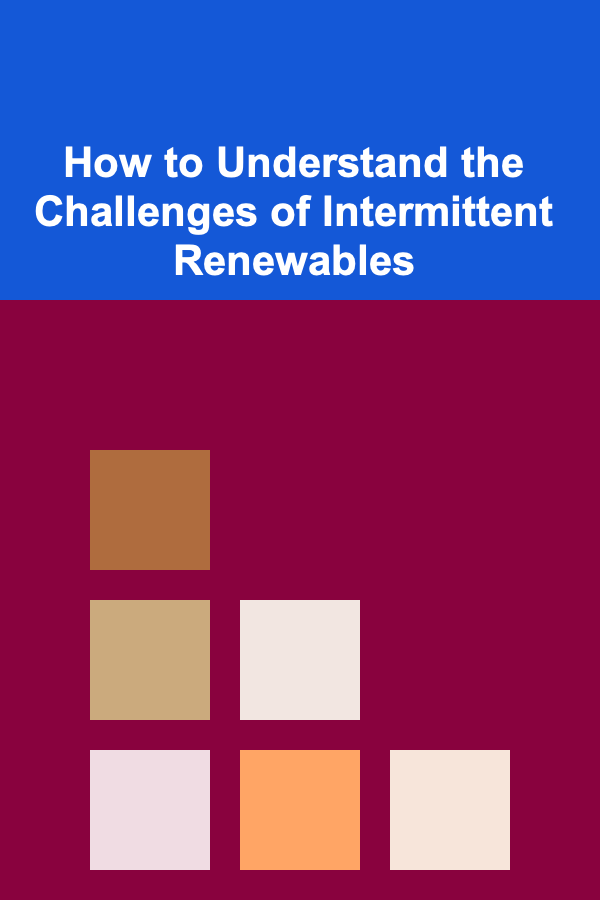
How to Understand the Challenges of Intermittent Renewables
ebook include PDF & Audio bundle (Micro Guide)
$12.99$9.99
Limited Time Offer! Order within the next:

The global energy landscape is undergoing a dramatic transformation, with renewable energy sources like wind, solar, and hydropower playing an increasingly central role in the world's efforts to reduce greenhouse gas emissions and combat climate change. However, while the transition to these cleaner energy sources is vital for sustainability, there are significant challenges associated with their integration into the power grid, particularly when these sources are intermittent in nature.
Intermittent renewable energy, like solar and wind, refers to energy that is not always available when it is needed, as it depends on weather conditions or the time of day. Unlike traditional energy sources such as coal, natural gas, or nuclear, which can generate power continuously, the variability and unpredictability of renewable sources pose unique challenges for grid operators and energy planners. This article delves into the nature of these challenges, the technological solutions being explored, and the broader implications for energy systems worldwide.
The Nature of Intermittency
The intermittency of renewable energy is inherent to the very nature of certain energy sources. For example, solar power generation is reliant on sunlight, which is only available during the day, and is further affected by factors such as weather conditions, cloud cover, and seasonal variations. Wind energy, similarly, depends on wind speeds, which are often inconsistent, with periods of calm or extreme weather conditions that may either limit or increase power generation. This variability introduces complexity into the planning and operation of energy systems.
The challenge, however, is not merely about the availability of renewable energy but also about the capacity to match energy supply with demand. Energy consumption is typically constant or follows predictable patterns, but the production of renewable energy is subject to variability and unpredictability. This mismatch can cause problems for grid operators, who need to balance supply and demand at all times to maintain the stability and reliability of the electricity system.
The Importance of Grid Stability
Grid stability is a key concern when integrating intermittent renewable energy. Electricity grids operate by ensuring that the amount of power being generated matches the amount being consumed, which requires a delicate balancing act. If supply exceeds demand, excess electricity can damage infrastructure or be wasted. On the other hand, if demand exceeds supply, it can result in power outages or blackouts.
Renewable energy sources like solar and wind can contribute to grid instability due to their unpredictable and fluctuating nature. For instance, a sudden drop in wind speed can reduce wind energy generation significantly in a short time, causing a supply gap. Similarly, an unexpected cloud cover can reduce solar power generation during peak demand periods. These fluctuations in renewable energy supply can make it difficult for grid operators to maintain a consistent and reliable supply of electricity.
The Challenges of Energy Storage
Energy storage plays a critical role in addressing the intermittency of renewable energy. By storing excess energy when production is high and releasing it when production is low, energy storage systems can help stabilize the grid and provide a continuous power supply. However, energy storage remains one of the most significant challenges in the renewable energy transition, as current storage technologies have limitations in terms of capacity, efficiency, and cost.
Battery Storage
Battery energy storage systems (BESS) are among the most widely discussed solutions for addressing the intermittency of renewable energy. Lithium-ion batteries, for instance, have been widely used for small-scale storage, but large-scale deployment for grid stabilization remains challenging. The cost of these batteries is a significant barrier, as they are expensive to produce and may not have the capacity to store enough energy to meet grid demands during prolonged periods of low renewable energy production.
Moreover, the environmental impact of battery production and disposal is another concern. Mining for lithium, cobalt, and other critical materials used in batteries can cause environmental degradation and human rights abuses in some regions. Additionally, while batteries can discharge energy quickly, their ability to store and discharge energy for extended periods is limited. This is particularly problematic in situations where renewable energy is unavailable for long stretches, such as in periods of calm weather or during winter months when sunlight is scarce.
Other Energy Storage Technologies
Other energy storage solutions are being explored to address the limitations of battery storage. These include pumped hydro storage, compressed air energy storage (CAES), and thermal energy storage. Pumped hydro storage, for example, involves using excess electricity to pump water to a higher elevation, where it can be stored in a reservoir. When needed, the water is released to generate electricity through turbines. While effective for large-scale storage, pumped hydro requires specific geographic conditions and can have significant environmental impacts on local ecosystems.
Compressed air energy storage (CAES) involves storing excess electricity by compressing air and storing it in underground caverns. When energy is needed, the compressed air is released and used to drive turbines. While CAES is promising, it requires large-scale infrastructure and may not be viable in all locations.
Thermal energy storage systems, such as molten salt or phase-change materials, store energy in the form of heat, which can be converted back into electricity when needed. While these systems can provide long-duration storage, they are still in the early stages of development and are limited by high costs and efficiency concerns.
The Role of Grid Flexibility
To manage the intermittency of renewable energy, grid operators must ensure that the grid is flexible enough to accommodate fluctuations in supply and demand. This means having the ability to quickly adjust power generation from various sources, such as fossil fuels, nuclear, or hydropower, to compensate for changes in renewable energy output.
Demand Response
One solution to enhance grid flexibility is demand response (DR), which involves incentivizing consumers to adjust their energy usage during peak demand periods. For example, utilities may offer lower electricity rates during times of high renewable energy availability (such as during the day when solar energy is abundant) and higher rates during periods of low renewable energy production (such as in the evening when solar power is no longer available).
By incentivizing consumers to shift their energy usage to times when renewable energy is plentiful, grid operators can reduce the strain on the grid and make better use of available renewable energy. However, demand response is only effective if there is widespread adoption, and consumer behavior can be challenging to change without significant incentives.
Virtual Power Plants (VPP)
Another approach to improving grid flexibility is the use of virtual power plants (VPPs). A VPP is a network of distributed energy resources, such as solar panels, wind turbines, batteries, and smart appliances, that are managed and controlled remotely to act as a single power plant. By aggregating many small-scale renewable energy systems, a VPP can respond more quickly to changes in supply and demand, smoothing out fluctuations and providing grid stability.
VPPs leverage advanced digital technologies and communication systems to optimize energy production, storage, and consumption in real-time. While the concept of VPPs holds great promise, challenges remain in terms of coordination, regulation, and the integration of diverse energy sources.
The Need for Grid Modernization
As renewable energy continues to grow in importance, the need for grid modernization becomes more pressing. Traditional grids were designed around centralized power generation, where large power plants fed electricity into the grid, which was then distributed to consumers. However, as more distributed energy resources (DERs) like rooftop solar panels and small-scale wind turbines are added to the grid, the infrastructure needs to be updated to handle this new, decentralized model of power generation.
Smart Grids
Smart grids are an essential part of this modernization process. A smart grid uses advanced sensors, communication systems, and data analytics to optimize the flow of electricity in real-time, allowing for better integration of renewable energy sources. Smart grids can detect fluctuations in energy supply and demand and automatically adjust the flow of electricity to maintain grid stability. They can also enable consumers to monitor and control their energy usage more effectively, which can contribute to demand response and overall grid efficiency.
Grid Interconnection
Another important aspect of grid modernization is the development of regional and international grid interconnections. By connecting different regions or countries through high-voltage transmission lines, grids can share energy across vast distances, balancing supply and demand in ways that would not be possible with isolated grids. For instance, when solar energy generation is high in one region but low in another, electricity can be transferred between the two areas to balance the overall supply.
Grid interconnections can also enhance energy security by providing access to a more diverse range of energy sources. For example, during a period of low wind generation, a region with access to hydroelectric power may be able to meet demand through cross-border electricity exchanges. However, creating these interconnections requires significant infrastructure investments and overcoming regulatory and political challenges.
Policy and Market Challenges
The integration of intermittent renewable energy also requires appropriate policy frameworks and market designs. The current energy markets are often based on outdated assumptions about energy supply, where large, predictable power plants provide the bulk of electricity. As more renewable energy sources are added to the grid, these market structures need to evolve to accommodate the variable nature of renewables.
Market Design for Renewables
Renewable energy markets often operate on price-based mechanisms, where electricity prices are determined by the cost of production. However, this approach does not adequately account for the value of flexibility, storage, and backup power that renewable energy systems require. To ensure that renewables are integrated efficiently into the grid, market designs must include mechanisms that incentivize energy storage, demand response, and grid flexibility.
Policy Support for Energy Transition
Government policies play a crucial role in facilitating the transition to renewable energy. Subsidies, tax incentives, and renewable energy targets can help drive investment in renewable technologies, storage solutions, and grid infrastructure. However, policies must be carefully designed to ensure that they support a smooth transition without creating market distortions or unfair competition.
Conclusion
Understanding the challenges of intermittent renewables is critical for navigating the energy transition and ensuring that renewable energy can play a central role in achieving global sustainability goals. From energy storage and grid flexibility to market design and policy support, addressing these challenges requires a comprehensive, multi-faceted approach. As technology continues to advance, and as grids evolve to become smarter and more interconnected, the integration of renewable energy into the global energy mix will become increasingly feasible, paving the way for a cleaner, more sustainable future.

Freelancing as a Path: How to Prepare for Alternative Careers
Read More
How to Create a Recipe Backup for Digital Safety
Read More
How To Give Difficult Feedback with Grace
Read More
How to Host a Family International Cuisine Night
Read More
How To Learn Bodyboarding: Riding Waves Prone
Read More
How to Optimize Healthcare Operations for Efficiency
Read MoreOther Products

Freelancing as a Path: How to Prepare for Alternative Careers
Read More
How to Create a Recipe Backup for Digital Safety
Read More
How To Give Difficult Feedback with Grace
Read More
How to Host a Family International Cuisine Night
Read More
How To Learn Bodyboarding: Riding Waves Prone
Read More